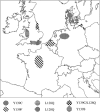The genetic basis of resistance to anticoagulants in rodents
- PMID: 15879509
- PMCID: PMC1449767
- DOI: 10.1534/genetics.104.040360
The genetic basis of resistance to anticoagulants in rodents
Abstract
Anticoagulant compounds, i.e., derivatives of either 4-hydroxycoumarin (e.g., warfarin, bromadiolone) or indane-1,3-dione (e.g., diphacinone, chlorophacinone), have been in worldwide use as rodenticides for >50 years. These compounds inhibit blood coagulation by repression of the vitamin K reductase reaction (VKOR). Anticoagulant-resistant rodent populations have been reported from many countries and pose a considerable problem for pest control. Resistance is transmitted as an autosomal dominant trait although, until recently, the basic genetic mutation was unknown. Here, we report on the identification of eight different mutations in the VKORC1 gene in resistant laboratory strains of brown rats and house mice and in wild-caught brown rats from various locations in Europe with five of these mutations affecting only two amino acids (Tyr139Cys, Tyr139Ser, Tyr139Phe and Leu128Gln, Leu128Ser). By recombinant expression of VKORC1 constructs in HEK293 cells we demonstrate that mutations at Tyr139 confer resistance to warfarin at variable degrees while the other mutations, in addition, dramatically reduce VKOR activity. Our data strongly argue for at least seven independent mutation events in brown rats and two in mice. They suggest that mutations in VKORC1 are the genetic basis of anticoagulant resistance in wild populations of rodents, although the mutations alone do not explain all aspects of resistance that have been reported. We hypothesize that these mutations, apart from generating structural changes in the VKORC1 protein, may induce compensatory mechanisms to maintain blood clotting. Our findings provide the basis for a DNA-based field monitoring of anticoagulant resistance in rodents.
Figures



References
-
- Alessandroni, P., S. Marchini, A. Bernardo, F. Terranova and P. G. Turillazi, 1980. Valutazione della presenza di ratti resistenti al warfarin nella citta di Reggio Calabria. Ann. Ist. Super. Sanita 16: 271–286. - PubMed
-
- Baert, K., 2003 Jaarrapport-Onderzoeksgroep Rattenbestijding, pp. 18–23. AMINAL afdeling Water, IBW, Geraardsbergen, Belgium.
-
- Bell, R. G., and P. T. Caldwell, 1973. Mechanism of warfarin resistance. Warfarin and the metabolism of vitamin K1. Biochemistry 12: 1759–1762. - PubMed
-
- Boyle, C. M., 1960. Case of apparent resistance of Rattus norvegicus Berkenhout to anticoagulant poisons. Nature 188: 517.
-
- Cain, D., S. M. Hutson and R. Wallin, 1997. Assembly of the warfarin-sensitive vitamin K 2,3-epoxide reductase enzyme complex in the endoplasmic reticulum membrane. J. Biol. Chem. 272: 29068–29075. - PubMed
Publication types
MeSH terms
Substances
LinkOut - more resources
Full Text Sources
Other Literature Sources
Medical
Molecular Biology Databases

